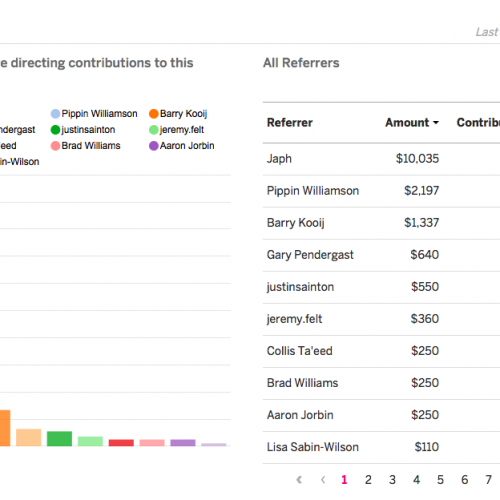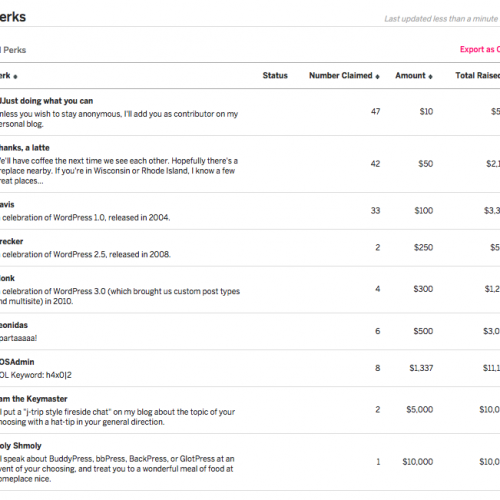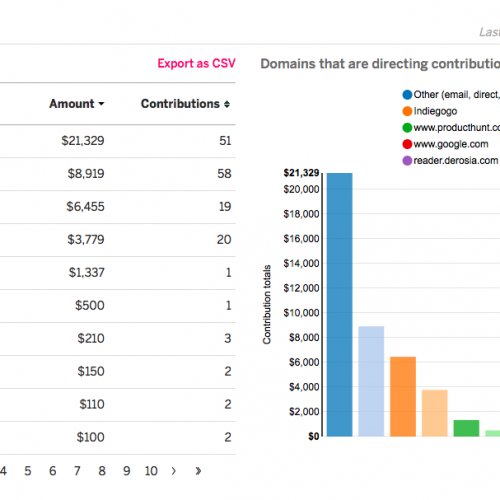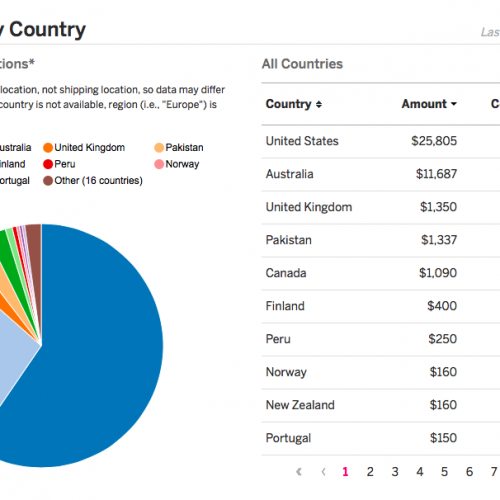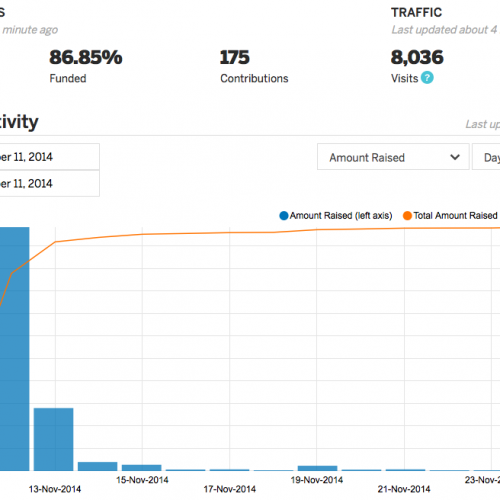In 2010 I took a job with the fine folks at Automattic. Having been contributing to WordPress, BuddyPress, and bbPress since 2007, working with the biggest company in the WordPress ecosystem seemed like the next logical step in my career. If you somehow haven’t heard of them, they’re a great company with open-source in it’s heart and transparency in it’s soul; there’s so much publicly available about Automattic that I’m comfortable bypassing the details completely.
In short, it’s an absolutely amazing company to work for, and if you’re still reading this, you should probably think about applying.
Fast forward to 2013. After a few lengthy conversations with the most influential people in my life at the time about career goals, experiences, and my personal bucket-list, I came to the conclusion it was time to move on from the job I once thought I didn’t deserve to the job I needed to have, to keep growing, to keep learning… somewhere I would be able to make a larger impact on a smaller group.
Welcome to 10up.
10up is a company you likely know less about juxtaposed to Automattic, but that doesn’t make them any less impressive. 10up and Automattic both rely heavily on the success of WordPress to create and craft wonderful online publishing experiences, sometimes even in a collaborative way where 10up clients are hosted on WordPress.com’s VIP network, where I did code review and deployments for almost 18 months. One of my favorite parts of working at 10up was, selfishly, getting to interact with my favorite old colleagues at Automattic from the other side of the fence. I (somewhat discretely) left 10up in July, but don’t let that discourage you from applying. They’re hugely into giving back to the WordPress project, and they have some of the coolest clients you could ever hope to have. Again; if you’re still reading, you are likely a good candidate to be a future 10upper.
10up, much like Automattic, is a distributed organization of talented individuals located all around the world, choosing to meet in the midst of the internet chaos to create amazing things together. (Their distributed work environments are so similar, I didn’t even need to change payroll providers when I made the change.) There are hundreds of employees now, all working from home offices, coffee houses, planes, trains, automobiles… anywhere internet access allows. I’m curious who will be the first to push code from space, or a submarine, or some kind of dirigible. The sky isn’t even the limit anymore when you work in a distributed environment; the limit is you.
For all of the clearly amazing perks, make no mistake, this style and environment is not for everyone. There is an enormous learning curve, and working alone for years at a time, collaborating with people you rarely (if ever) see in the physical universe around you, undoubtedly comes with associated costs that are not made obvious until you’re already (feeling) committed to the cause.
When I started at Automattic I already knew what it meant to communicate effectively online; I’ve been doing it since around 1994 through AOL chat rooms, IRC channels, and SourceForge. Still, I didn’t truly appreciate what 100+ people across 100+ internally networked sites (used for managing projects and initiatives) would look like. The fury of activity, the fomo, the persistent connection & constant availability; it’s a lifestyle change not just for you and your career, but your family, friends, pets, etc…
You start carrying your laptop with you to dinner, because if something under your umbrella gets wet, you’re responsible for wiping up the mess. You meticulously configure notifications on your several devices to only alert you to the things you can directly impact and control. You stay up later, wake up later, pull a few all nighters; it’s exhilarating and rewarding and incredibly easy to slide into and painfully difficult to come out of. Maybe you get paired up with someone with different work habits than you, or are asked to work on a project you’re not passionate about. It’s not all WordPress all the time; it’s a job, where someone is paying you to do whatever needs doing, even if it’s not what you signed up for originally.
Yes… you’re changing the world, usually for the better. You go Spiderman on the world at the expense of going Peter Parker on your life. You sacrifice things (or relationships) you love for a perceivably greater good. This isn’t unique to a distributed work environment, but I think it is easier to identify someone starting to lose it when they show up to the office wearing a latex suit flinging imaginary spider-webs at the ceiling VS reading between written updates because you haven’t physically seen them in 6 months.
I guess what I’m saying is, when you work without seeing your colleagues on the regular, it’s incredibly easy for extremely unhealthy habits to go completely unnoticed (or be unintentionally encouraged) for extended periods of time. In a physical office, you pick up on body language, subtle cues, inflection, cadence, and you can smell when someone had a rough night at the pub and maybe shouldn’t be pushing code to 60 million sites. When that closeness doesn’t exist, you learn to be hypersensitive to written tone changes, fluctuations in the frequency of communicating, and increases or decreases in all areas of output, otherwise you’ll never notice someone’s physical or mental health decline. I know this isn’t unique to distributed working environments (it kinda sounds like college) but it is much easier to fly under the radar for longer periods of time before anyone notices.
At the risk of derailing myself, I think working from home for extended periods of time and not going at least a little crazy makes you evolutionarily superior. I’m convinced our primitive minds aren’t quite wired correctly (yet) to work from isolated pods for 8 hours a day, sometimes 7 days per week, for the rest of our lives, even if we get to decide when and where and how to do it. Maybe we’ll find that balance someday, and the future of work may be a division of physical and virtual labor, but this transitional period we’re in right now (where the first of us are figuring it out) sometimes feels like a dark and lonely place.
Succeeding within a distributed workforce requires a very specific set of interpersonal skills (Luca talks more about them here.) You need to be empathetic and supportive, but can’t be sensitive to criticism. You need to be confident, but not arrogant, because that bleeds through the virtual folds quite profusely. Communication is, perhaps ironically, more important than output (technically, it IS output) because no one knows what you’re doing unless you tell them you’re doing it. Communicate early, clearly, constantly, and follow-up on your follow-ups. You need to find a pattern in the chaos, and either lead people through it or risk being absorbed by it.
To be honest, even after 2 decades of online collaboration and leadership, I’m not sure how particularly great I am at it compared to the people I’ve seen actually be great, but that hasn’t stopped me yet from experimenting and learning and growing. I do stay in touch with a fair few of my Automattic and 10up family members, but companies, even distributed ones, are purposely inclusive, so I also try not to encroach.
Speaking of companies, Flox is nearly shippable, and I’m putting energy on the side into an agency focusing on creating great community sites with BuddyPress & bbPress. If you have any leads, I will greatly appreciate you and them.
I’m leaving comments open for Q&A about working in distributed environments like Automattic’s & 10up’s. Please feel comfortable asking anything you’d like, and I promise I’ll answer to the best of my ability. If you work at Automattic or 10up, and have anything else to add, please feel free. <3
